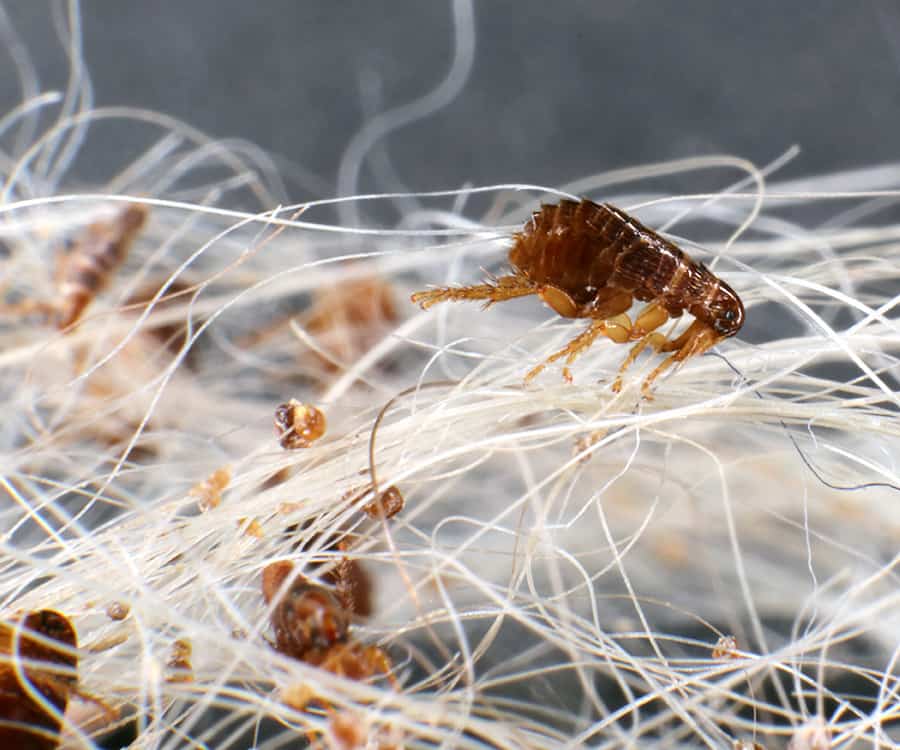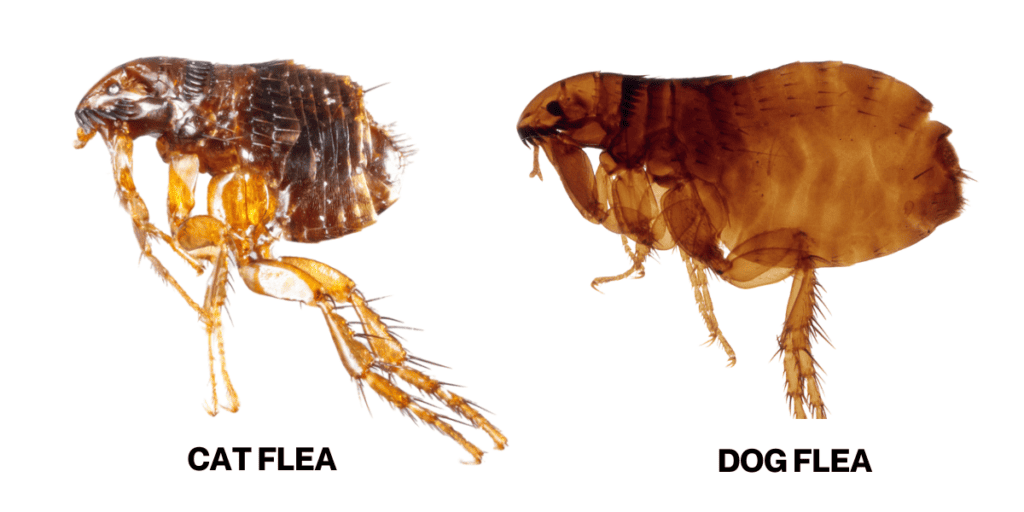Fleas are notorious, tiny parasites that cause distress for both pets and humans alike. A common question that arises about these pests is whether they can survive cold temperatures. Knowing the answer to this question has implications for pet owners, as well as those interested in flea biology and life cycles.
In this article, we delve into the intriguing ways fleas adapt to cold weather and explore the impact that low temperatures have on their survival.
POINTS
- Fleas can survive cold temperatures as low as 37 degrees Fahrenheit (3 degrees Celsius) by finding shelter and warmth, but their activity and survival rates decrease as the temperature drops.
- While many fleas die in the winter, especially when exposed to extreme cold without shelter, some can survive by finding refuge on hosts or in insulated areas.
- The survival rate of fleas during winter varies greatly between indoor and outdoor environments, with those in warmer indoor environments having a higher chance of survival.
- Cold weather can kill fleas, especially if exposed to subfreezing temperatures for an extended period, but surviving fleas may retreat to more insulated spaces or hosts for warmth and sustenance.
- Understanding that fleas can survive cold weather emphasizes the importance of maintaining year-round flea control measures, such as regular pet treatments, vacuuming, and washing pet bedding.
How do Fleas Adapt to the Cold?
What characteristics allow fleas to survive in cold conditions?

Fleas employ a variety of adaptations to withstand cold environments, enabling them to survive in conditions that are less than ideal for their lifecycle. Below is a table detailing these key characteristics and explaining how each contributes to the flea’s ability to persist through colder weather.
| Adaptation | Description |
|---|---|
| Small Size | Minimizes heat loss, allowing fleas to retain warmth more efficiently. |
| Shelter Seeking | Fleas seek shelter in warm, insulated spaces, such as the fur of hosts or within human habitats, to avoid direct exposure to cold. |
| Quiescence | By entering a state of reduced metabolic activity, fleas conserve energy and survive longer periods in cold temperatures. |
| Host Dependence | Relying on the warmth of their hosts, fleas can maintain a viable temperature for survival in otherwise inhospitable conditions. |
| Insulation Utilization | Utilizing the insulating properties of environments like nests or debris, fleas protect themselves from the cold. |
These adaptations highlight the fleas’ remarkable ability to navigate and endure the challenges posed by cold weather, making year-round flea control essential.
How cold can fleas survive?
Fleas can survive temperatures as low as 37 degrees Fahrenheit (3 degrees Celsius) and in some cases, even colder conditions, depending on the species and their surroundings. However, their activity level and survival rate decrease as temperatures drop, making them vulnerable under extreme cold.
Does the cold kill fleas or do they simply become less active?
Cold temperatures can indeed kill fleas, especially if they are exposed to subfreezing conditions without any shelter. However, when fleas find protection from the cold, such as in the fur of their hosts or in the warmth of indoor environments, they can survive by becoming less active and conserving energy. This means that fleas can still be a problem even in cold weather. The table below illustrates how different temperature ranges impact flea activity, providing insight into their behavior during cold weather.
| Temperature Range (°F/°C) | Flea Activity Level | Notes on Survivability |
|---|---|---|
| Above 70°F / 21°C | Highly Active | Optimal conditions for feeding and reproduction. |
| 50°F to 70°F / 10°C to 21°C | Moderately Active | Activity slows down; feeding and reproduction are less frequent but still occur. |
| 37°F to 50°F / 3°C to 10°C | Less Active | Survival possible; fleas seek warmth and shelter, entering a state of reduced activity. |
| Below 37°F / 3°C | Dormant/Inactive | Fleas enter a quiescent state or die if exposed without shelter; survival heavily dependent on finding warmth and insulation. |
Do fleas prefer the cold, or do they simply tolerate it?
Fleas do not prefer cold temperatures. They are ectothermic organisms, meaning that their body temperature depends on their environment. Fleas thrive in warm and humid conditions, typically between 70 and 85 degrees Fahrenheit (21 to 29 degrees Celsius). While they can survive in colder temperatures, they are simply tolerating it rather than thriving in it.
What Happens to Fleas in Winter?
Do fleas live in winter?

Yes, fleas can live in winter, but their survival rate and activity level decrease with falling temperatures. Moreover, their lifecycle is intricately affected by cold weather, with each stage responding differently to lower temperatures. This table provides an overview of how the cold impacts the egg, larva, pupa, and adult stages of fleas, offering insights into their survival strategies during winter.
| Flea Life Stage | Impact of Cold Weather |
|---|---|
| Eggs | Development slows down significantly or halts, with a higher mortality rate in freezing conditions. |
| Larvae | Growth is inhibited in cold temperatures; larvae seek warmer spots and insulation to survive. |
| Pupae | Cold weather can extend the pupal stage, as fleas remain in their cocoons until conditions are favorable for emergence. |
| Adults | Activity levels decrease; adults seek warmth and hosts to survive, potentially entering a quiescent state in extreme cold. |
How long can fleas live in winter?
The lifespan of fleas in winter largely depends on their environment. A flea can live anywhere from a few days to a few months. During the winter months, fleas can continue to survive if they find shelter from the cold and have a host to feed on. In contrast, fleas exposed to extreme cold without protection are likely to die within a shorter time frame.
Do fleas die in the winter or do they find ways to survive?

While many fleas do die in the winter, especially when exposed to extreme cold and lack shelter, some fleas find ways to survive, such as by seeking refuge on hosts or in insulated areas. If they can obtain enough warmth and sustenance, they can continue reproducing, ensuring the infestation persists even during the coldest months.
Can fleas live in winter without a host?
Fleas have a difficult time surviving in winter without a host. They require blood meals from a host to reproduce, and without a source of nourishment, both adult fleas and their offspring face a reduced chance of survival. Additionally, the lack of a host’s warmth makes them more vulnerable to the cold.
Does the survival rate of fleas differ between indoor and outdoor environments during winter?
Yes, the survival rate of fleas during winter varies greatly between indoor and outdoor environments:
- Indoors, fleas can find warmth, shelter, and hosts, allowing them to continue their life cycle and remain active.
- Outdoors, however, are more susceptible to the cold and can die if they are exposed to freezing temperatures for an extended period without protection.
How Does Cold Weather Impact Fleas on Pets?
Do fleas on cats die in the winter?

While it is possible for fleas on cats to die during winter, especially when exposed to cold temperatures, it is not guaranteed that all fleas will be eliminated. Fleas are resilient and may survive by hiding in the warmer areas of your cat’s fur, especially if your pet spends time indoors or has access to a warm shelter.
Does cold weather kill fleas on cats?
Cold weather can potentially kill fleas on cats, but it usually depends on the specific conditions to which the fleas are exposed. Prolonged exposure to freezing temperatures might be fatal for the fleas, whereas fleas in temperate zones or living indoors can still survive throughout the winter.
How does the winter survival rate of fleas differ between pets kept indoors and those exposed to outdoor cold?
The winter survival rate of fleas is significantly higher in pets kept indoors compared to those exposed to outdoor cold.
- Indoor pets are likely to have a more stable and warm environment, providing fleas with the necessary conditions to survive and reproduce.
- Outdoor pets, however, may come across more drastic temperature fluctuations, potentially leading to higher flea mortality rates.
What Temperatures Kill Fleas?
At what temperature do fleas die?
Fleas begin to die when exposed to temperatures below 37 degrees Fahrenheit (3 degrees Celsius) for an extended period. However, freezing temperatures (32 degrees Fahrenheit / 0 degrees Celsius) have a faster and more effective impact on killing fleas. It is important to note that flea eggs, larvae, and pupae may have different tolerance levels to cold temperatures than adult fleas.
| Flea Life Stage | Temperature for Mortality (°F/°C) | Exposure Duration |
|---|---|---|
| Eggs | Below 37°F / 3°C | Prolonged exposure (several days to weeks) |
| Larvae | Below 37°F / 3°C | Prolonged exposure (several days to weeks) |
| Pupae | Below 32°F / 0°C | Extended periods (weeks) |
| Adults | Below 37°F / 3°C | Short-term exposure (hours to days) |
High heat temperatures between 104°F to 113°F (40°C to 45°C) can effectively kill adult fleas, eggs, larvae, and pupae by causing dehydration, stress, and disrupting their reproductive cycle.

Does prolonged exposure to certain temperatures kill fleas faster?
Yes, prolonged exposure to cold temperatures, especially freezing or subfreezing conditions, can kill fleas faster. The longer fleas are unable to access warmth and shelter, the lesser their chances of survival and replication.
Does the killing temperature vary among different species of fleas?
The killing temperature does vary slightly among flea species, but most have similar temperature thresholds. The cat flea (Ctenocephalides felis) and the dog flea (Ctenocephalides canis) can withstand temperatures as low as 37 degrees Fahrenheit (3 degrees Celsius) and may even survive colder temperatures in some cases. However, flea species found in colder climates may be more adapted to withstand lower temperatures than those found in warmer regions.

Do Fleas Go Away in Cold Weather?
When do fleas go away?
Fleas may appear to go away or diminish during cold weather due to a decrease in their activity levels and numbers. However, fleas that have found a suitable host or a warm indoor environment can maintain their presence throughout the year.
When do fleas die outside in the cold?
Fleas generally begin to die outside when exposed to temperatures below 37 degrees Fahrenheit (3 degrees Celsius) for an extended period, with quicker and more effective outcomes as temperatures drop further or when freezing conditions are present.
When do fleas go away outside in cold weather?
Fleas may appear to disappear outside in cold weather as their activity levels decrease, and many of them die due to cold temperatures. This, however, does not mean that they are completely gone, as some fleas may survive by:
| Strategy | Description |
|---|---|
| Finding Warm Hosts | Fleas seek out warm-blooded animals to maintain necessary body heat and access food sources. |
| Seeking Shelter | They find refuge in insulated areas such as animal nests, homes, or within thick fur to avoid direct exposure to cold. |
| Entering Quiescence | Fleas can enter a state of reduced metabolic activity, conserving energy and surviving with minimal resources. |
| Utilizing Insulation | By exploiting the insulating properties of materials like bedding and debris, fleas protect themselves from freezing temperatures. |
| Reproduction Delay | Some flea populations may delay reproduction until conditions become more favorable, focusing on survival over growth. |
Will cold weather kill fleas or just cause them to retreat?
Cold weather can kill fleas, but it can also cause them to retreat to more insulated spaces to find warmth and sustenance. Fleas are opportunistic parasites and will do everything they can to survive, which may include becoming less active or seeking shelter from the cold.
Conclusion: The Resilience of Fleas to Cold
Can fleas indeed survive cold weather?
Fleas can indeed survive cold weather, but their ability to do so depends on various factors such as the species, their environment, and the availability of hosts. While many fleas die when exposed to cold temperatures for extended periods, some may survive by finding warmth, shelter, and sustenance.
What does the survival of fleas in cold weather mean for flea control strategies?
Understanding that fleas can survive cold weather reinforces the importance of maintaining diligent flea control measures year-round. Even though flea populations may decrease during winter, assuming that cold weather will entirely eliminate a flea infestation is a mistake. For an effective approach to flea control that adapts to the resilience of fleas throughout the year, consider the following strategies along with their effectiveness ratings and optimal usage conditions:
- Regular Pet Treatments: Best used year-round, especially crucial for pets with access to the outdoors to prevent fleas.
- Vacuuming: Ideally conducted indoors, targeting carpets, furniture, and pet resting areas to remove flea eggs, larvae, and adults.
- Washing Pet Bedding: Recommended year-round, with increased frequency during warmer months, to eliminate fleas and their larvae.
- Flea Traps and Monitors: Useful indoors for assessing and managing adult flea populations.
- Environmental Treatments: Applicable both indoors and outdoors, particularly in areas frequented by pets, to target fleas at all life stages.
- Professional Pest Control: Advised year-round, especially for dealing with severe infestations or as a preventative strategy.
How does understanding the cold resilience of fleas contribute to our overall understanding of their biology and life cycle?
Recognizing the cold resilience of fleas provides a deeper insight into their biology and life cycle. By comprehending how fleas adapt to cold temperatures and the strategies they employ to survive colder conditions, we can tailor our efforts in pest control more effectively. In turn, this knowledge allows us to develop more targeted approaches to combat fleas and protect our pets, homes, and ourselves from these persistent parasites.
While cold weather does have an impact on fleas’ survival and activity, it is not a guaranteed solution to eliminate flea infestations. It is crucial for pet owners and individuals dealing with fleas to remain vigilant and maintain consistent flea control measures throughout the year. By understanding the resilience of fleas in cold conditions, we can better identify, control, and prevent these pests from causing harm in our lives.



